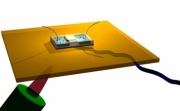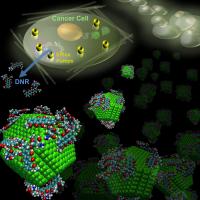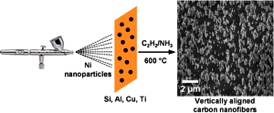Science
Molecules pass through nanotubes at size-dependent speeds

A diagram of one of the group's experimental setups shows a copper plate that can be heated using a torch underneath it, to study the effect of temperature on the process. On top of the plate, an apparatus consisting of two reservoirs separated by a silicon structure that has a single carbon nanotube on top of it. When a power source is connected to the electrodes (the wires extending up from the device), charged molecules (ions) from one of the reservoirs can pass through the tube, and its progress can be monitored using a scanning electron microscope.
- Read more
- 418 reads
New system uses nanodiamonds to deliver chemotherapy drugs directly to brain tumors

These images show the retention of doxorubicin and ND-DOX in brain tissue, with light microscopic images (upper rows) and fluorescence images detecting fluorescence generated from doxorubicin (lower rows). The images show the distribution of unmodified doxorubicin and ND-DOX after convection-enhanced delivery (CED) at 6, 16, 24 and 72 hours.
- Read more
- 332 reads
Team Attempts to Restore Communications

Artist's concept of NASA's Deep Impact spacecraft.
- Read more
- 338 reads
Tiny diamonds to boost treatment of chemoresistant leukemia: Novel discovery by scientists from NUS and UCLA enhances delivery and retention of leukemia drug, paving the way for nanodiamonds to be used for chemotherapeutics

By binding multiple molecules of Daunorubicin with nanodiamonds, scientists from NUS and UCLA managed to boost the delivery of the drug to leukemic cells and retain the drug within the cells to combat the cancer.
- Read more
- 336 reads
Airbrushing Could Facilitate Large-Scale Manufacture of Carbon Nanofibers

This image illustrates how researchers use an airbrush to grow vertically aligned carbon nanofibers. Click to enlarge.
- Read more
- 327 reads
DSCOVR Mission Moves Forward to 2015 Launch

Solar Flares captured by GOES 15 SXI.
- Read more
- 484 reads
Comet Found Hiding in Plain Sight

With the help of NASA's Spitzer Space Telescope, astronomers have discovered that what was thought to be a large asteroid called Don Quixote is in fact a comet.
- Read more
- 496 reads
New center to better understand human intelligence, build smarter machines: NSF awards $25 million to MIT-based center to advance brain understanding

The hope is that through building intelligent machines, we can better understand ourselves.
- Read more
- 554 reads
Human Rights
Fostering a More Humane World: The 28th Eurasian Economic Summi

Conscience, Hope, and Action: Keys to Global Peace and Sustainability

Ringing FOWPAL’s Peace Bell for the World:Nobel Peace Prize Laureates’ Visions and Actions

Protecting the World’s Cultural Diversity for a Sustainable Future

Puppet Show I International Friendship Day 2020



